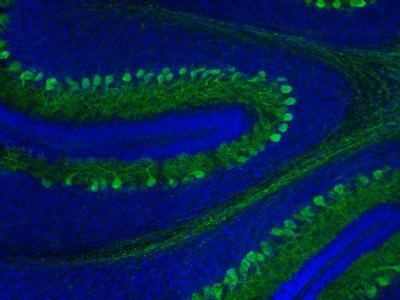Symbol CALB1 Entrez 793 OMIM 114050 | Alt. symbols CALB HUGO 1434 RefSeq NM_004929 | |
 | ||
What does calbindin mean
Calbindin refers to several calcium-binding proteins. They were originally described as vitamin D-dependent calcium-binding proteins in the intestine and kidney in the chick and mammals. They are now classified in different sub-families as they differ in the number of Ca2+ binding EF-hand sites.
Contents
- What does calbindin mean
- Calbindin 1451 1453 1457 stack
- Calbindin D28k
- Calretinin
- Calbindin D9k
- References
Calbindin 1451 1453 1457 stack
Calbindin-D28k
Calbindin-D28k was first shown to be present in the intestine in birds and then found in the mammalian kidney. It is also expressed in a number of neuronal and endocrine cells, particularly in the cerebellum. It is encoded in humans by the CALB1 gene.
Calbindin-D28k contains 4 active calcium-binding domains, and 2 modified domains that have lost their calcium-binding capacity. Calbindin-D28k acts as a calcium buffer and calcium sensor and can hold four Ca2+ in the EF-hands of loops EF1, EF3, EF4 and EF5. The structure was solved using high-resolution NMR and which was one of the largest proteins then to be determined. The sequence of Calbindin is 263 residues in length and has only one chain. The sequence consists mostly of alpha helicies but beta sheets are not absent. According to the PDB it is 44% helical with 14 helices containing 117 residues, and 4% beta sheet with 9 strands containing 13 residues.
Calbindin-D28k is a vitamin D responsive gene in many tissues, in particular the chick intestine, where it has a clear function in mediating calcium absorption. In the brain, its synthesis is independent of vitamin-D.
There is no homology between calbindin-D28k and calbindin-D9k, apart from their calcium binding domains (EF-hands): calbindin-D9k has two EF-hands, and calbindin-D28k has six.
Calretinin
Calretinin is a 29kDa protein with 58% homology to calbindin-D28k and principally found in nervous tissues. It is encoded in humans by the CALB2 gene.
Calbindin-D9k
Calbindin-D9k is present in mammalian intestinal epithelial cells (enterocytes). Calbindin-D9k can also be found in the kidney and uterus in some mammalian species. It in encoded in humans by the S100G gene which has also been termed CALB3.
Calbindin-D9k is a member of the S100 family of calcium-binding proteins. It has two EF-hands sequences which bind Ca2+ with high affinity.
Calbindin-D9k mediates the transport of calcium across the enterocytes from the apical side, where entry is regulated by the calcium channel TRPV6, to the basolateral side, where calcium pumps such as PMCA1 utilize intracellular adenosine triphosphate to pump calcium into the blood. The transport of calcium across the enterocyte cytoplasm appears to be rate-limiting for calcium absorption in the intestine; the presence of calbindin increases the amount of calcium crossing the cell without raising the free concentration. Calbindin-D9k may also stimulate the basolateral calcium-pumping ATPases. Expression of calbindin-D9k, like that of calbindin-D28k, is stimulated by the active vitamin D metabolite, calcitriol although the precise mechanisms are still controversial. In mice in which the receptor for vitamin D is not expressed, calbindin-D9k is reduced, but not absent.
